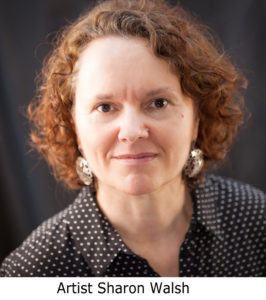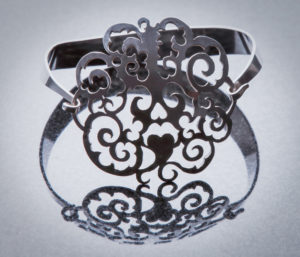A Conversation With an Artist, Part One
By B. Kim Barnes, Barnes & Conti CEO
 In these challenging times, we need to call upon our creativity more than ever. We are currently in the process of transforming our Applied Creativity and Managing Innovation programs into webinars to meet the moment. In appreciation of this most precious and important human capacity, I would like to share a conversation I recently had with someone who epitomizes the spirit of creativity in her work and her life.
In these challenging times, we need to call upon our creativity more than ever. We are currently in the process of transforming our Applied Creativity and Managing Innovation programs into webinars to meet the moment. In appreciation of this most precious and important human capacity, I would like to share a conversation I recently had with someone who epitomizes the spirit of creativity in her work and her life.
Sharon Walsh is a jewelry artist from the area around Donegal in Ireland. I met her in a serendipitous way, through a Flickr connection with her brother, a photographer. I was enchanted with her work as seen on her website and how she combined Irish history, mythology, and their tradition of strong women in her designs. She is in the process of launching her business, ST Rose Jewellery. (Spelling is an example of how our cultures differ and yet are similar.) I thought it would be interesting to interview her as both an artist and an entrepreneur. Below is the first part of our conversation, slightly edited.
BKB: How do you see curiosity linked to creativity?
SW: The drive to see ‘what happens if’ pushes us to pursue possibilities and permits fresh perspectives to emerge. Childhood play is our initiation into creativity. Play allows for fluidity, for failure, for success; it nurtures resilience and tenacity. Play is curiosity in action and curiosity is a corollary of creativity. Artists retain the desire to play, developing it into a form acceptable for adult engagement, whereupon it is described as creativity. In domains such as science or engineering we talk about invention or innovation – creativity by another name.
Engaging in the artistic process has allowed me to follow my curiosity into the limitless space that is the contemporary art world – an engagement both intellectually rewarding and life- affirming. The only rule in the art discourse is that there are no rules. My work is an exploration of the threshold between representation and abstraction. The results of this undertaking manifest in drawings and three-dimensional objects. A synthesis of many ideas and processes, driven by curiosity, led to the first ST Rose Jewellery collection.
The job of the artist is to embrace curiosity, to connect seemingly disparate ideas and concepts, to play with ambiguity, to explore the endless possibilities for deconstructing meaning and re-arranging reality.
BKB: How do you ensure that your work aligns with your personal values?
SW: It is important that ST Rose Jewellery is conducted along ethical lines. I am keen to ensure that the business is sustainable by making informed, conscious – and conscientious – choices. I want to grow the business organically, with careful management. I am aware that extensive choices about how to live are not freely available to everyone, so I want to include less privileged people in the business in ways that are beneficial both for them and their community. This characterizes the ethos of the business and will inform decisions around methods of production. Any future outsourcing of work needs careful monitoring to make sure that it is carried out in a responsible way. It is also important to me that my business is as environmentally friendly as possible.
BKB: In what ways can ancient wisdom inform our current reality? How can myths and legends help us to solve problems creatively?
SW: “The friend of wisdom is also a friend of myth.” – Aristotle. Much academic literature exists that examines the significance of myth and legend in human society. Child Psychologist Bruno Bettelheim and Psychiatrist Nossrat Peseschkian, amongst others, have looked at how ancient tales endure worldwide as tools for guidance, for modelling behaviour and for giving meaning to life.
 Irish myths and legends hold a special interest for me, in particular The Táin, the principal tale of the Ulster cycle. Much of the action takes place in the area where I was brought up. The poet Thomas Kinsella tells us in his translation of The Táin that it is “the oldest vernacular epic in Western literature.” Women are central to the ancient tales of Ireland, and are portrayed in the Táin as strong, vital characters that drive the narrative forward. Whether as deities or as warriors, the female figures of ancient Ireland had agency and power, a power that reaches out to us and urges us to exert influence on the contemporary world, to fight for what we believe in.
Irish myths and legends hold a special interest for me, in particular The Táin, the principal tale of the Ulster cycle. Much of the action takes place in the area where I was brought up. The poet Thomas Kinsella tells us in his translation of The Táin that it is “the oldest vernacular epic in Western literature.” Women are central to the ancient tales of Ireland, and are portrayed in the Táin as strong, vital characters that drive the narrative forward. Whether as deities or as warriors, the female figures of ancient Ireland had agency and power, a power that reaches out to us and urges us to exert influence on the contemporary world, to fight for what we believe in.
Narrative helps us to construct our reality and to create our own personal myth. We tell ourselves stories about ourselves and our place in the world. We hone and refine these stories all our lives. Inspired by Irish myths and legends, I wanted to create jewellery that contains an implied narrative – not defined by any particular text. I wanted to make pieces that hold space for our own story… a tangible connection to the human need for myth, but also an invitation to re-work our individual myth in ways that bring us joy. I [want my work to provide a] physical connection to our own story, reminding us to tap into our inner resources, giving us freedom to play with fantasy and fable…never slavishly mimicking the past, but honouring it and adapting it to suit our own particular needs, using it as a source of inspiration. This is not to promote magical thinking, but to challenge it, pushing us to break the constraints of superstition and allow for real growth through playfulness. We need to relish what makes us different and to acknowledge and encourage difference in others as a way to enrich our world.
Note: The photo above is of one of Sharon Walsh’s creations. You can see more on her website

Leave a Reply
You must be logged in to post a comment.